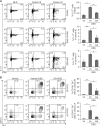Decursinol Angelate Ameliorates Dextran Sodium Sulfate-Induced Colitis by Modulating Type 17 Helper T Cell Responses
- PMID: 30917627
- PMCID: PMC6720537
- DOI: 10.4062/biomolther.2019.004
Decursinol Angelate Ameliorates Dextran Sodium Sulfate-Induced Colitis by Modulating Type 17 Helper T Cell Responses
Erratum in
-
Erratum to "Decursinol Angelate Ameliorates Dextran Sodium Sulfate-Induced Colitis by Modulating Type 17 Helper T Cell Responses" [Biomol. Ther. 27 (2019) 466-473].Biomol Ther (Seoul). 2020 Mar 1;28(2):211. doi: 10.4062/biomolther.2019.221. Biomol Ther (Seoul). 2020. PMID: 32103653 Free PMC article. No abstract available.
Abstract
Angelica gigas has been used as a Korean traditional medicine for pain relief and gynecological health. Although the extracts are reported to have an anti-inflammatory property, the bioactive compounds of the herbal plant and the effect on T cell responses are unclear. In this study, we identified decursinol angelate (DA) as an immunomodulatory ingredient of A. gigas and demonstrated its suppressive effect on type 17 helper T (Th17) cell responses. Helper T cell culture experiments revealed that DA impeded the differentiation of Th17 cells and IL-17 production without affecting the survival and proliferation of CD4 T cells. By using a dextran sodium sulfate (DSS)-induced colitis model, we determined the therapeutic potential of DA for the treatment of ulcerative colitis. DA treatment attenuated the severity of colitis including a reduction in weight loss, colon shortening, and protection from colonic tissue damage induced by DSS administration. Intriguingly, Th17 cells concurrently with neutrophils in the colitis tissues were significantly decreased by the DA treatment. Overall, our experimental evidence reveals for the first time that DA is an anti-inflammatory compound to modulate inflammatory T cells, and suggests DA as a potential therapeutic agent to manage inflammatory conditions associated with Th17 cell responses.
Keywords: Angelica gigas; Decursinol angelate; IL-17; Type 17 helper T cell; Ulcerative colitis.
Conflict of interest statement
We wish to confirm that there are no known conflicts of interest associated with this publication and there has been no significant financial support for this work that could have influenced its outcome.
Figures





References
-
- Boschetti G, Kanjarawi R, Bardel E, Collardeau-Frachon S, Duclaux-Loras R, Moro-Sibilot L, Almeras T, Flourie B, Nancey S, Kaiserlian D. Gut inflammation in mice triggers proliferation and function of mucosal Foxp3+ regulatory T cells but impairs their conversion from CD4+ T cells. J Crohns Colitis. 2017;11:105–117. doi: 10.1093/ecco-jcc/jjw125. - DOI - PubMed
LinkOut - more resources
Full Text Sources
Research Materials

